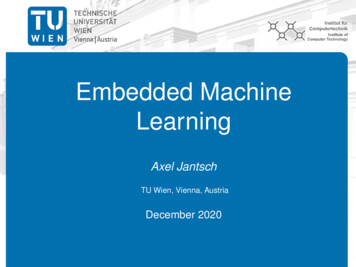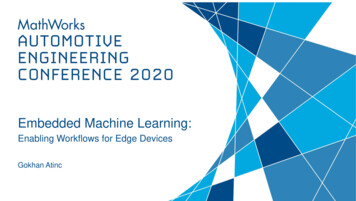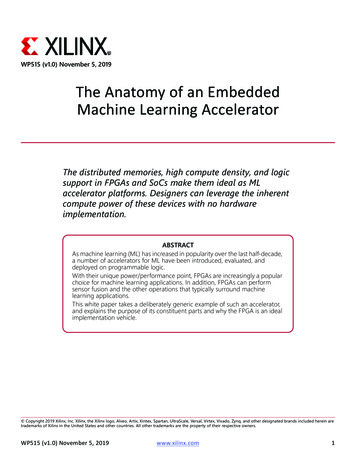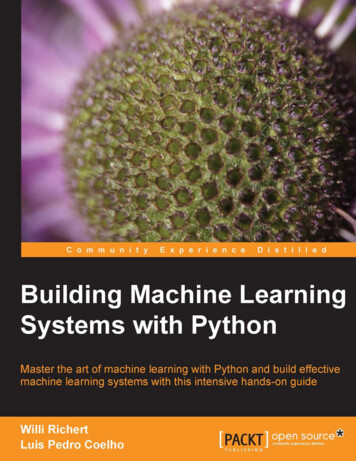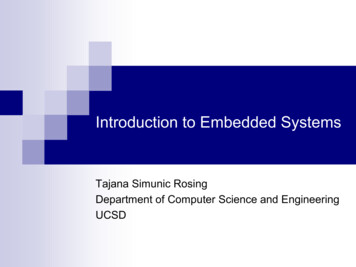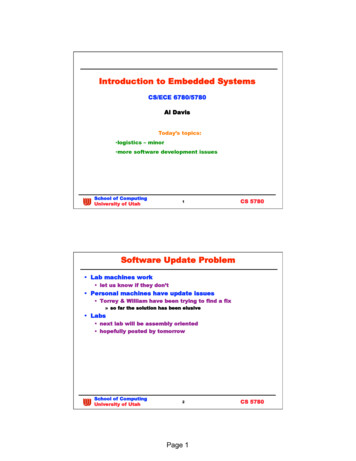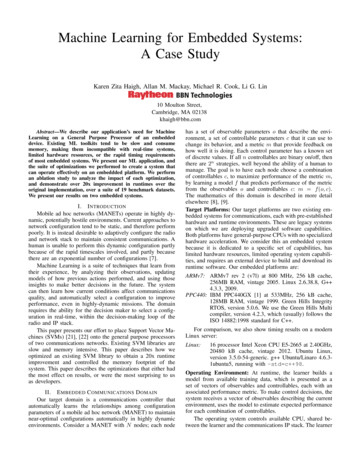
Transcription
Machine Learning for Embedded Systems:A Case StudyKaren Zita Haigh, Allan M. Mackay, Michael R. Cook, Li G. Lin10 Moulton Street,Cambridge, MA 02138khaigh@bbn.comAbstract—We describe our application’s need for MachineLearning on a General Purpose Processor of an embeddeddevice. Existing ML toolkits tend to be slow and consumememory, making them incompatible with real-time systems,limited hardware resources, or the rapid timing requirementsof most embedded systems. We present our ML application, andthe suite of optimizations we performed to create a system thatcan operate effectively on an embeddded platform. We performan ablation study to analyze the impact of each optimization,and demonstrate over 20x improvement in runtimes over theoriginal implementation, over a suite of 19 benchmark datasets.We present our results on two embedded systems.I. I NTRODUCTIONMobile ad hoc networks (MANETs) operate in highly dynamic, potentially hostile environments. Current approaches tonetwork configuration tend to be static, and therefore performpoorly. It is instead desirable to adaptively configure the radioand network stack to maintain consistent communications. Ahuman is unable to perform this dynamic configuration partlybecause of the rapid timescales involved, and partly becausethere are an exponential number of configurations [7].Machine Learning is a suite of techniques that learn fromtheir experience, by analyzing their observations, updatingmodels of how previous actions performed, and using thoseinsights to make better decisions in the future. The systemcan then learn how current conditions affect communicationsquality, and automatically select a configuration to improveperformance, even in highly-dynamic missions. The domainrequires the ability for the decision maker to select a configuration in real-time, within the decision-making loop of theradio and IP stack.This paper presents our effort to place Support Vector Machines (SVMs) [21], [22] onto the general purpose processorsof two communications networks. Existing SVM libraries areslow and memory intensive. This paper describes how weoptimized an existing SVM library to obtain a 20x runtimeimprovement and controlled the memory footprint of thesystem. This paper describes the optimizations that either hadthe most effect on results, or were the most surprising to usas developers.II. E MBEDDED C OMMUNICATIONS D OMAINOur target domain is a communications controller thatautomatically learns the relationships among configurationparameters of a mobile ad hoc network (MANET) to maintainnear-optimal configurations automatically in highly dynamicenvironments. Consider a MANET with N nodes; each nodehas a set of observable parameters o that describe the environment, a set of controllable parameters c that it can use tochange its behavior, and a metric m that provide feedback onhow well it is doing. Each control parameter has a known setof discrete values. If all n controllables are binary on/off, thenthere are 2n strategies, well beyond the ability of a human tomanage. The goal is to have each node choose a combinationof controllables c, to maximize performance of the metric m,by learning a model f that predicts performance of the metricfrom the observables o and controllables c: m f (o, c).The mathematics of this domain is described in more detailelsewhere [8], [9].Target Platforms: Our target platforms are two existing embedded systems for communications, each with pre-establishedhardware and runtime environments. These are legacy systemson which we are deploying upgraded software capabilities.Both platforms have general-purpose CPUs with no specializedhardware acceleration. We consider this an embedded systembecause it is dedicated to a specific set of capabilities, haslimited hardware resources, limited operating system capabilities, and requires an external device to build and download itsruntime software. Our embedded platforms are:ARMv7: ARMv7 rev 2 (v7l) at 800 MHz, 256 kB cache,256MB RAM, vintage 2005. Linux 2.6.38.8, G 4.3.3, 2009.PPC440: IBM PPC440GX [1] at 533MHz, 256 kB cache,128MB RAM, vintage 1999. Green Hills IntegrityRTOS, version 5.0.6. We use the Green Hills Multicompiler, version 4.2.3, which (usually) follows theISO 14882:1998 standard for C .For comparison, we also show timing results on a modernLinux server:Linux:16 processor Intel Xeon CPU E5-2665 at 2.40GHz,20480 kB cache, vintage 2012. Ubuntu Linux,version 3.5.0-54-generic. g Ubuntu/Linaro 4.6.31ubuntu5, running with -std c 98.Operating Environment: At runtime, the learner builds amodel from available training data, which is presented as aset of vectors of observables and controllables, each with anassociated performance metric. To make control decisions, thesystem receives a vector of observables describing the currentenvironment, uses the model to estimate expected performancefor each combination of controllables.The operating system controls available CPU, shared between the learner and the communications IP stack. The learner
BBN REPORT-8571TABLE 1.operates asynchronously, returning a decision when finished.Notably, the PPC440 platform’s real-time operating systemexplicitly allows us to directly control how much CPU thelearner can use. The speed of the decision maker thereforedirectly affects which controllable parameters to capture inthe learned model: any controllables that must be chosen morerapidy than the learner can handle are not candidates.Development Team: Our development team had one MachineLearning expert, one hard-real time embedded expert, andone C algorithms expert. We also received code reviewsand consulting from the individuals most familiar with theplatforms (hardware and software).SourceUCI [2]Weka [10]Weka [10]UCI [25],[2]Weka [10]Weka [10]Weka [10]LIAAC [23]UCI [4],[2]UCI ustomCustom2186 instancesplatforms, so we conducted the initial tests on a modernLinux server. We only tested those packages that compiledwithin approximately an hour after download: if the softwarewouldn’t compile easily on a modern platform, it would beextremely painful to migrate it to the older platforms.To select the specific package from which to continuedevelopment, we ran the suite of benchmark datasets listedin Table 2. Table 3 shows the timing results; Weka’s SMORegis the fastest in all but a few cases. LibSVM is 2.0x slowerthan Weka on average.1 Dlib is 10.4x slower than Weka onaverage; moreover DLib gets worse the bigger the dataset (e.g.4.1x when fewer than 1000 instances, and 15.6x when morethan 1000 instances).Given these results, we decided to rely on the SVMimplementation found in Weka [10], with Ũstün’s Pearson VIIUniversal Kernel (Puk) [21] and Platt’s Sequential MinimalOptimization algorithm [17] to compute the maximum-marginhyperplanes.ω describes the shape of the curve; as ω 1, it resembles aLorentzian, and as it approaches infinity, it becomes equal toa Gaussian peak. σ controls the half-width at half-maxima.The regression function then becomes:(2)i 1where n is the number of training instances that becomesupport vectors, αi and αi are Lagrange multipliers computedwhen the model is built (see Üstün et al [21]).There are many available implementations SVMs,e.g., [12], [24]. We considered language (preference for C ),licenses, memory usage, and compilation effort. Table 1lists some of the options that are available in C withlicenses appropriate for our work. We did not consider Javaimplementations because of its higher memory requirementsand because Java is not compatible with other softwarecomponents on our target platform. We also eliminatedseveral packages that rely heavily on malloc() calls, asdynamic memory usage is both slow and likely to causeruntime errors on our RAM-limited hardware. None of theremaining libraries directly compiled on our embedded targetHaigh et alLicenseUnlimited with copyrightUnlimited with copyrightGNU Lesser GPLFree for scienceGNU Lesser GPLGNU GPLTest NameDescriptionInstances AttribsairfoilAirfoil noise15036AutoPriceAutomobile prices15916bodyfatPercentage bodyfat25215concreteConcrete compressive strength10309cpuCPU relative performance2277fishcatchFish weight1598housingBoston housing values50614†poleTelecommunications1499826wine redWine quality, red159912†wine whiteWine quality, white489812commsA-TPCommunications throughput107859commsA-Lat Communications latency107859commsB-TPCommunications throughput82059commsB-LatCommunications latency82059commsC-TPCommunications throughput37859commsC-LatCommunications latency37859commsD-TPCommunications throughput173244commsD-Lat Communications latency173244commsD-BER Communications bit error rate173244† Due to memory restrictions on our embedded platforms, we usedon the target platforms.where x are the attributes (combined o and c), where w is aset of weights (similar to a slope) and b is the offset of theregression function.When the original problem is not linear, we transform thefeature space into a high-dimensional space that allows usto solve the new problem linearly. In general, the non-linearmapping is unknown beforehand, and therefore we perform thetransformation using a kernel, φ(xi , x), where xi is an instancein the training data that was selected as a support vector, x isthe instance we are trying to predict, and where φ is a vectorrepresenting the actual non-linear mapping. In this work, weuse the Pearson Universal Kernel [21] because it has beenshown to work well in a wide variety of domains, and wasconsistently the most accurate in our target communicationsdomain:1φ(xi , x) (1) p 2 ωp1 σ2 xi x 2 (2(1/ω) 1)(αi αi ) φ(xi , x) bLanguageC C , JavaC CC Java, C TABLE 2. We measured performance against 19 regression datasets, ofwhich 10 are standard benchmarks, and 9 represent different scenarios in ourtarget communications domain.m f (x) w, x bnXSeveral SVM packages are available in C .SoftwareDLib ML [15]LibSVM [3]Shark [11]SVMLight [13], [14]TinySVM [16]Weka [6], [10], [18]III. M ACHINE L EARNING AND R EGRESSIONSupport Vector Machines [21], [22] are ideally suited tolearning this regression function from attributes to performance. The regression function is commonly written as:m f (x) March 16, 2015IV. O PTIMIZATIONSOur first working C implementation was based onSMOReg in WekaC [18], with a translation of WekaJava [6]items that were not already in the C version. We refer tothis version as Baseline.This paper describes the optimizations that either hadthe most effect on our results, or were the most surprisingto us as developers. These include numerical representations(double vs float vs integer) algorithmic constructs (kernel,memory vs compute), data structures (vectors), and compilertricks (flattening object structure, inlining, exceptions). We also1 An implementation of LibSVM is also available as part of Weka; we usedthe direct download [3].2ML for Embedded Systems
BBN REPORT-8571TABLE 3. Weka performs faster than other SVM librarieson our modern Linux server.were only called in one or two places in the code, and thuswe did not suffer from a bloated assembly.TestcaseWeka DLib C ne red433ms1,066ms9,127mswine white2,626ms5,257ms 68,006mspole22,571ms 186,928ms ms746ms7,788mscommsD-BER790ms954ms7,600msB. Numerical RepresentationsThe SVM code relies on many floating point mathematicsoperations. To build a SVM, the code repeatedly computesa predicted value and its corresponding error, and stops thealgorithm when error is sufficiently low. It is therefore criticalto find a numerical representation that can be computed quicklyand still meet accuracy requirements.We performed the unit tests of Table 5 on our targethardware for 64-bit double, 32-bit float, 32-bit integer,and a fixed point representation [5], [20]. Neither platform hasa floating point co-processor. The results in Table 6 indicatethat integer computations take only 1% of double precisionand 3% of float operations on PPC440 (3% and 8% onARMv7 respectively). Fixed Point was extremely slow; Table 7and Table 8 show the assembly for the Fixed Point multiplyaccumulate operation on ARMv7 and PPC440 respectively.The PPC440 requires eight instruction for each load, add,multiply, divide, and store on a fixed point value, explainingthe extremely slow timing results.We eliminated fixed point representation because the timingresults were so poor, and then updated the Weka code to support side-by-side testing of the other representations. We alsodeveloped an intermediate mixed int float version intendedto take advantage of the integer speed improvements withoutimpacting accuracy.1) Double: All numbers in Weka are 64-bit double, usinga type definition, InstData.2) Float: All numbers in Weka are 32-bit float, using atype definition, InstData.3) Integer: All numbers in Weka are 32-bit integer. Ourapproach was to scale all of the values α and kernel parametersby a scaling factor F, and scale the data (or target values) anderror by F 2 .4) Mixed Float and Integer: To leverage the potentialtiming improvement from integer math as indicated by Table 6,while not losing as much accuracy as for a fully integer representation, we focussed on converting the two key inner loops:dotProd() and SVMOutput(), both of which are multiplyaccumulate loops. dotProd() computes the dot productbetween two instances; it is called 2n2 times, for n instances inthe dataset. SVMOutput() calculates the predicted value fora given instance, per Equation 2. It is a function the Lagrangianmultipliers α, and the kernel evaluation k. SVMOutput()is called app
Machine Learning for Embedded Systems: A Case Study Karen Zita Haigh, Allan M. Mackay, Michael R. Cook, Li G. Lin 10 Moulton Street, Cambridge, MA 02138 khaigh@bbn.com Abstract—We describe our application’s need for Machine Learning on a General Purpose Processor of an embedded device. Existing ML toolkits tend to be slow and consumeFile Size: 498KBPage Count: 12


